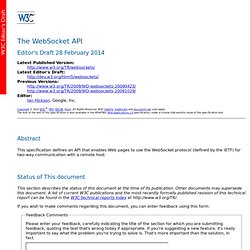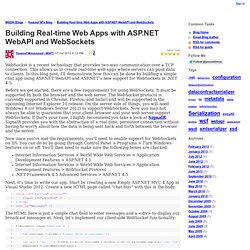

Customizable, Ubiquitous Real-Time Communication over the Web. Abstract An API is described for sourcing and terminating streams of real-time media in a browser.

The API provides a means of describing how media streams are serialized into a stream of RTP packets or deserialized from a stream of packets. The API is structed in two sections: Real-Time Media Streaming and Real-Time, Peer-to-Peer Transport. Status of This Document This document is merely a public working draft of a potential specification. Table of Contents 1. Thanks in no small part to the exponential improvements in Web infrastructure over the last few years, it is now possible to leverage the digital backbone of the Internet to create experiences for which dedicated media and networks (cable TV, telephone) were necessary until not too long ago.
Inexpensive, real time video conferencing is one such experience. But there are other applications of the same general technology, which are also experiencing substantial growth. Gimite/web-socket-js. Wpf Over Websockets (WoW) – How to Pump WPF windows & animations to browsers over HTML5 Websockets And Canvas. Over the weekend, I just put together a hack for pumping WPF windows over Websockets and rendering it using HTML5 canvas – also with basic mouse input support.

For each user connecting to the server, a new window instance is created, and screen will be pumped over web sockets to the browser as base64 encoded images. These images are painted on an HTML5 canvas. The entire source code is here at codeplex – What does this mean? Once HTML5 specification is final - it is almost certain that it’ll be the most widely adopted platform for delivering applications to end users. You can see that I’m accessing my WPF application over multiple browsers in the below video. Rendering the screen in the browser HTML5 draft specification includes Websockets - Here is a pretty minimized implementation of the page that opens a web socket, retrieve the image data, and draws the same on a canvas. RFC 6455 - The WebSocket Protocol. Fleck - WebSocket. WebSocket.org The Benefits of WebSocket. By Peter Lubbers & Frank Greco, Kaazing Corporation (This article has also been translated into Bulgarian.)
Lately there has been a lot of buzz around HTML5 Web Sockets, which defines a full-duplex communication channel that operates through a single socket over the Web. HTML5 Web Sockets is not just another incremental enhancement to conventional HTTP communications; it represents a colossal advance, especially for real-time, event-driven web applications. HTML5 Web Sockets provides such a dramatic improvement from the old, convoluted "hacks" that are used to simulate a full-duplex connection in a browser that it prompted Google's Ian Hickson—the HTML5 specification lead—to say: "Reducing kilobytes of data to 2 bytes…and reducing latency from 150ms to 50ms is far more than marginal.
Let's take a look at how HTML5 Web Sockets can offer such an incredibly dramatic reduction of unnecessary network traffic and latency by comparing it to conventional solutions. HTML5 Web Sockets to the Rescue! Pusher HTML5 WebSocket Powered Realtime Messaging Service. Source Checkout - sipml5 - The world's first HTML5 SIP client (WebRTC) The WebSocket API. Abstract This specification defines an API that enables Web pages to use the WebSocket protocol (defined by the IETF) for two-way communication with a remote host.

Status of This document This section describes the status of this document at the time of its publication. Other documents may supersede this document. A list of current W3C publications and the most recently formally published revision of this technical report can be found in the W3C technical reports index at If you wish to make comments regarding this document, you can enter feedback using this form: You can also e-mail feedback to public-webapps@w3.org (subscribe, archives), or whatwg@whatwg.org (subscribe, archives). Implementors should be aware that this specification is not stable. The latest stable version of the editor's draft of this specification is always available on the W3C CVS server and in the WHATWG Subversion repository. E-mail notifications of changes Commit-Watchers mailing list (complete source diffs):
XSockets.NET. Interop Notes. Andyet/signalmaster. HTML5Labs - Home. Building Real-time Web Apps with ASP.NET WebAPI and WebSockets - Youssef M's Blog. WebSocket is a recent technology that provides two-way communication over a TCP connection.

This allows us to create real-time web apps where servers can push data to clients. In this blog post, I’ll demonstrate how this can be done by building a simple chat app using ASP.NET WebAPI and ASP.NET’s new support for WebSockets in .NET 4.5. Before we get started, there are a few requirements for using WebSockets. It must be supported by both the browser and the web server. The WebSocket protocol is currently supported in Chrome, Firefox, and Safari and will be supported in the upcoming Internet Explorer 10 release. Now once you’ve met the requirements, you’ll need to enable support for WebSockets on IIS. A WebSocket Community. Nugget: Web Socket Server - Home. SimpleWebRTC.js from &yet.
Is WebRTC ready yet? Apidaze WebRTC Workshop barcelona 21st april 2013. WebRTC.